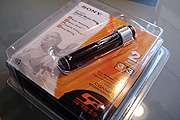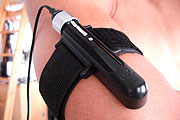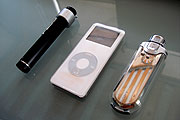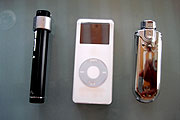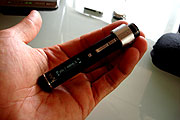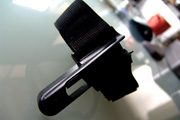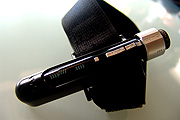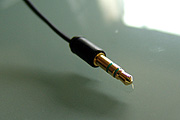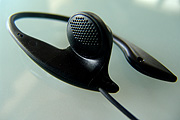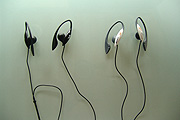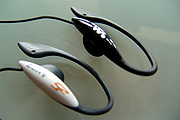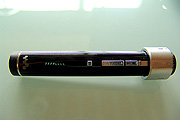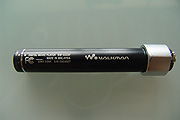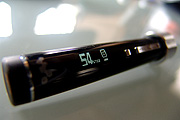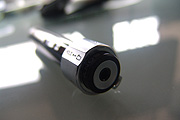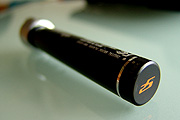Sony S2 Sports Walkman NW-S205F

Introduction
I’ll admit it. I’m a sucker for Sony products even though they have this tendency to disappoint me in some way. Although we seem to be living in an iPod-centric world, it’s nice to see there are still other companies releasing nice digital audio players so that you actually have a choice. While Sony hasn’t exactly done a stellar job in this area, they still have managed to bring out some really nice products that ooze Sony’s sense of style, unique functionality, and expertise in consumer electronics.
Nowadays, it’s not uncommon to see people with digital audio players everywhere. At my local gym, nearly everyone has some sort of digital audio player on their arm as they stair-climber their way to mastery over their caloric intake. Knowing that digital audio player use during exercise is a very common activity, several manufacturers have began designing and marketing new products specifically for exercise. Of course, every company has a different definition of what this means. For some, it simply means making a more robust player that’s water resistant, includes an arm band, or has a more rugged exterior. Philips was one of the early marketers of such products even teaming up with Nike with limited success.
However, the latest trend is adding more sports-related features that enhance your workouts. The first notable example of this was Apple’s Nike+iPod Sport Kit. This add-on to the popular iPod nano, allows the iPod nano to keep track of your time or distance of your walk or run and integrating with Apple’s own iTunes.
Not to be left out, Sony’s new S2 Sports Walkman introduces Sony’s entry into this new genre of digital audio players to help you keep track of your workouts. Let’s take a look at how Sony’s implementation works and whether it’s worth getting.
Sony S2 Sports Walkman
The Sony S2 Sports Walkman (also known as the NW-S205F) reviewed here represents the current flagship model of Sony’s new line of sports-activity digital audio players. For the North American market, all the models are black in color. There is also a NW-S203F model which is functionally equivalent but comes in a smaller capacity (1GB). The Japanese domestic market has other colors available. The unit is pretty diminutive and surprisingly light. For size comparison, here’s a shot of the device compared to other players and my hand.
The NW-S205F has the following specifications:
• 2GB Built-In Memory / Stores 1350 Songs
• Built in FM Tuner
• 1-Line EL (Organic Electroluminescence) Display
• Super Quick Battery Charge3 (3 min charge = 3 hrs playback)
• Up to 18 Hours of Playback Life with Rechargeable Embedded Battery
• Plays Back in MP3/AAC (non-DRM)/WMA(non-DRM)/ATRAC3®/ATRAC3plus™ Audio Formats and WAV files
• Weight:0.9 oz. (26g)
• Dimensions: 3.79 x 0.78 x 0.59” (96.5 x 15 x 15mm)
The Sony S2 Sports Walkman includes unique features such as being water resistant and having a music pacer, a calorie counter, and a stop watch.
One new thing that Sony’s digital audio players have added most recently is the ability to play AAC and WMA files. Don’t get all excited though…it’s only for non-DRM’d files. What this means is your iTunes-purchased songs won’t work without a “burn & re-rip”. At any rate, it’s nice to see Sony giving users choice of codec now. Of course, most of the units tend to “perform” better when you’re using the ATRAC3 compression but there’s a reason for that.
The unit also comes with a USB cable, software CD, an armband, and a pair of Sony MDR-J011 Clip-On headphones. The headphones are nearly identical to Sony’s MDR-J11G Sports Clip-On headphones (which I happen to have). The MDR-J011 included headphones has a straight style stereo jack connector and the headphone wires run-down the left side of your head. I’m not a huge fan of these headphones for reasons I will discuss below.
G-Sense Pedometer and the S2 Sports Walkman Experience
So, does it work?
Well, for the past several months, I’ve been using the Sony S2 Sports Walkman on most of my runs to see how well it worked. So, I’ll be discussing accuracy and usability along with some things I found along the way.
ACCURACY
Out of the box, I found the unit to be eerily accurate once I entered in my height, weight, and run/walk stride length. You have the option of entering in inches/lbs or cm/kg for your measurements. While not completely scientifically accurate, I used my car’s odometer along with a separate GPS unit to get baseline measurements of my typical runs. For my 4, 6, and 8 mile courses, I found the Sony S2 Sports Walkman to be accurate within +/- 0.1 miles which is acceptable and comparable to another unit I’m testing, Apple’s iPod nano and Nike+.
Essentially, the G-Sensor in the Sony S2 Sports Walkman measures the number of steps you take and then calculates the distance based on your stride. Additionally, it calculates the estimated number of calories you’ve burned based on the information you’ve provided about yourself. The device knows when you’re walking or running and switches playlists accordingly if you choose.
USABILITY
With the G-Sensor enabled, you have several options on how you want it to track your movement. The most common setting will be G-Sensor enabled only during music playback or use of the FM tuner. Within this, there are two ways this can work. First, you can either manually control your playlists or songs in order or in shuffle mode. Secondly, you can utilize Music Pacer, a feature that allows you to assign specific playlists depending on if you’re walking or running. So, you might want a faster playlist when you’re running to keep you motivated and something more mellow when you’re cooling down or simply walking.
I like how Sony’s implementation of the Music Pacer feature. Let’s say you’re running and you come to the end of your workout. As you start walking, the running playlist you’re listening to will fade gently and then you will hear a voice say, “Please Enjoy Walking Musicâ€. Later, if you starting running again then the walking playlist will fade out and you’ll be greeted with “Please Enjoy Running Music†as your running music fades in. Cheesy? Maybe, but it works well.
In regards to the G-Sensor’s other settings, there is also an “anytime†mode. The purpose of this mode is to keep track of your step count and amount of calories consumed throughout the day regardless of music playback or not. This mode uses more battery life than normal. You can also turn it off completely if you’re not in the mood to be “measuredâ€.
When you’ve completed your workout, you can check the device to see the statistics of your run and record the information into your running journal or other preferred tool (if you do that sort of thing). From what I can tell, it will keep track at least a month’s worth of information and you can go into the history to scroll through your past workouts.
My assumption is that most people won’t fiddle with playlists while they’re running. However, if you decide that you need to skip or replay a song then it’s pretty easy to do. All you need to do is pull the jog-dial up one notch (assuming you’re using the HOLD function) and twist left or right. To switch playlists, you do the same method by pulling the jog-dial up two notches instead. Volume adjustments are adjusted easily as well with just a push of the volume rocker switch. I almost forgot to mention that Sony adds one sort of shameless feature to this player. Named Shuffle Shake, this feature allows you to switch between normal playback and shuffle playback modes simply by shaking the player (face up) 3 times. I’ve tried it and it works but I never use it.
Finally, I like the fact that it’s nearly impossible for the Sony S2 Sports Walkman to fall out of the armband but it’s easily extracted and replaced when the need arises.
COMFORT
With the included armband, the Sony S2 Sports Walkman is more or less unnoticeable because it’s so light. That is, the unit is so light that you really won’t notice it even after long usage. Some people may find the armband a little abrasive and not as soft as other types of armbands. If you’re wearing it over a sleeve then it won’t be an issue.
The headphones are a mess. The only thing I like about them is that they have a straight-type stereo jack. Why so harsh? Well, it’s not because I don’t like clip-on type headphones. Rather, the design of the included headphones is NOT suited for the activity most people will be doing which I assume to be running. The MDR-J011 headphones utilize the “around-the-neck†design where one ear serves as the “main†ear and the other ear serves as the “satellite†ear. The “main†ear has the main cord that connects to the digital audio player. This creates a weight imbalance and any tug on the main cord will eventually pull the left headphone out of your ear. On long runs, the constant jostling and whipping of the cord (from the impact of running and the elements) and the addition of perspiration can make for an annoying run. Bad Sony!
Ironically, Sony’s own S2-branded MDR-J11G Sports Clip-On headphones are virtually identical in design; however, they use an evenly distributed cord design and includes a clothing clip to minimize cord movement. Why wouldn’t Sony include these headphones instead?
Build Quality
The Sony S2 Sports Walkman has what I would call “typical Sony fit and finishâ€. This refers to Sony’s great expertise in making consumer electronics feel nice and polished. Despite the light weight of the unit, the body is solid with no apparent creaking when you squeeze the body and buttons just feel good.
The OLED screen utilizes Sony’s hidden mirror screen design found on many of their digital audio players. The color of the OLED is a bright white and it’s more readable in direct sunlight compared to their past offerings. It’s a little slim with a single line display but it’s more than adequate given the form factor of the unit. It’s very scratch resistant and even after months of heavy use it barely shows any marks and the screen remains readable.
The jog-dial mechanism is what you would expect from Sony. That means it’s rock-solid and works very well. Like other Sony digital audio players, the jog-dial has three states.
1. Group/Album/Playlist
2. Song Select
3. Hold
The buttons feel good and have unique enough touch so that you can operate the unit without looking at it. The design also allows for one handed operation which is ideal during workouts since you don’t need to look down and fumble with controls. The unit is designed for you to use your thumb to control everything.
The included armband which is a nice since these things typically cost anywhere from $19-29 USD. The band itself is more or less comfortable but it is somewhat abrasive. Sony could have used a softer cloth or material on the inside part that comes in contact with the skin. The plastic frame holds the unit in place very well and allows one to operate the device without needing to remove it. If you do need to remove it then it’s very easy to pull out the unit, make a change and then quickly put it back. Love it.
Finally, the unit has a rubberized cap on the bottom that protects the mini-USB port from moisture. The cap is attached to the unit (from the inside) so you won’t lose it.
Connectivity
The Sony S2 Walkman utilizes a standard mini-USB port for connecting to a PC. I really love this feature since I have a bunch of other devices (digital camera, Sony Playstation Portable, etc.) that use the same cable. Sony includes a cable and when plugged in, the Sony S2 Sports Walkman is recognized as a USB Mass Storage Device. In addition, the cable also serves to charge the device whenever it’s connected. While the device is touted as USB 2.0 compatible, I don’t believe the device itself actually transfers at USB 2.0 speeds because it’s slow. Transfer speeds are somewhere around 1.5MB/s.
Finally, the headphone jack is located at the top of the device. Like all others it’s amplified and does not offer an option for line level output.
Interface
When you first turn on the S2 Sports Walkman, the device is ready to start playing on any previous settings that you have left the unit on (i.e. playlist or album play).
The main interface is the square-shaped DISP/HOME button. Pressing the button quickly cycles through the various display modes. The cycle is as follows:
• Basic: The basic screen. Typically, this is the mode you were last using.
• Property: Displays song information like bit rate, file type, sound settings.
• Step: Shows you your step count and distance covered.
• Calorie: Shows you how many calories you’re allegedly burned so far.
• Clock: Shows you the date and time.
• Animations: Displays animations (sort of a screensaver if you will)
The screen will go off after a few seconds unless you have the power saving feature off.
Holding down the DISP/HOME button will bring you to the HOME menu. It looks like the following:

You always start in the middle and you can only see the first 5 icons in the dotted box. You’ll need to use the jog-dial to move left or right to see the other icons. If you pause on each item a description will pop-up explaining what the icon means. The PLAY/STOP button acts as “select†while the DISP/HOME button acts as a “back†button.
There’s actually quite a bit of settings you can change and the manual does a decent job of explaining the functionality of everything. Briefly, I’ll lay out what each of the icons does.
• Search: This only appears when Sports Mode is NOT active.
• Sports Mode: You can enable Sports Mode and set your target time, distance (mile or kilometer), or calories (in kCal). Additionally, you can set playlists for Walk/Run modes and set the Music Pacer (changes playlists depending on if you’re walking or running).
• Stopwatch: A basic stopwatch feature.
• All Songs: Allows you to play all songs/albums (depending on jog-dial position).
• FM: Allows you to scan for radio stations or select presets (depending on jog-dial position).
• Playlist: Allows you to switch between playlists or songs within those playlists.
• Settings: Where you can configure everything in the device. This includes play and sorting modes, FM presets, volume levels, equalizer settings, height/weight settings, G sensor settings, date/time, power saving, counter history, etc.
Overall, the interface is more of less straightforward. Once you have everything setup the way you like, you’ll most likely leave the settings alone.
Transferring Music
The Sony S2 Sports Walkman requires use of Sony’s Connect/SonicStage 4.x software. As many people know, this is Sony’s latest and best version of the software but unfortunately, that’s not saying very much. Basically, it works but really isn’t the best music jukebox software out.
SonicStage allows you to rip music from CD directly into MP3, AAC or ATRAC3/Plus formats. Additionally, it will convert WAV, WMA, and MP3 tracks into ATRAC3 format if you choose to do so.
When plugged into a system, the Sony S2 Sports Walkman will be recognized by SonicStage and you can simply transfer entire albums or single tracks over to the device. Alternatively, you can copy playlists over and it will copy the associated music over. The only frustrating thing about how the S2 Sports Walkman handles playlists is that you cannot edit the playlists once they’re on the device. That means you can’t drag over a single file to the playlist. Instead, you’ll have to update the playlist on your system first and then transfer over.
I have one new gripe about SonicStage. The Sony S2 Sports Walkman proudly boasts that it includes a Multi Language Display. The following quote comes directly from the product website.
Displays encoded text in English and foreign languages that can include the artist name, disc name, and/or track name.
The most outrageous thing about this is that Sony’s own software doesn’t support multiple languages so there’s no way you could even take advantage of this. Clearly, this needs to be addressed especially when you consider both Apple iTunes and Microsoft Windows Media Player both support unicode and multiple languages. Bad Sony again!
And yes, there are workarounds but there shouldn’t have to be.
Sound Quality
Judging sound quality is a subjective matter and even more so when testing this sort of device. Because, the device was designed for workout activities, a major deciding factor will be what kind of headphones you’re using and what is the type of environment you’re in. The other major factor is the quality of your source material.
My music collection consists of mostly MP3s ranging from 128kbps to 320kbps. For headphones, I used my trusty white Sony MDR-EX71SL in-ear headphones for my baseline tests. I also used the included headphones Sony MDR-J011 along with a pair of Sony MDR-J11G S2 Sports Clip-On style headphones which are essentially identical but with some minor differences.
With my Sony MDR-EX71SL in-ear headphones, the sound is both clear and full although the bass seems to be a little punchy. Still, it sounds on par with my NW-E507 that I reviewed before and is very clean. With these headphones, I can push the volume close to 28 (out of 30) before I start noticing any distortion.
When using the Sony MDR-J011 and MDR-J11G headphones, the sound is only adequate. There’s a noticeable loss of bass which means you’ll have to turn the volume up a bit. The sound is actually pretty loud at volume level 14 but starts to distort pretty quickly once you hit level 17. You would imagine that these kinds of headphones don’t fully isolate and in some ways, it’s a good thing. Both headphones let in just enough noise so you’re aware of your surroundings which can be a good thing if you’re running outside on the road and still want to be aware of the sounds of traffic.
On the Sony S2 Sports Walkman, you have a 5-band equalizer that allows you to change each band +/- 3 steps. This allows for a lot of flexibility in how you like to listen to your music.
The FM sound quality is excellent especially when the signal is clean. Living in Los Angeles, I have access to pretty good signals. I was actually surprised at how well the FM functionality works. I would like to see AM radio support too since I listen to a lot of talk radio and most of my favorite stations are in AM.
As always on Sony portable audio devices, you have the AVLS (Automatic Volume Limiting System) which attempts to keep the volume level normalized if you have different songs recorded at different levels.
I’m happy to say that the Sony S2 Sports Walkman supports gapless playback but only if you import ATRAC encoded songs. Unless you’ve owned Sony digital audio players in the past you won’t care since you never had this feature before anyways.
Battery Life
Sony claims 18 hours of battery life and as usual their claim is more or less substantiated. I can go a full week of workouts before worrying about the battery draining out. My workout times tend to be 60-120 minutes per session at least five times per week. In my book, that’s pretty impressive.
Even better, if I’m about to head to the gym or go out for a run and the battery looks low, I can simply plug it in for 3 minutes and get about 3 hours of play.
Final Thoughts
So, let’s recap my findings.
Good: Solid design, lightweight, very good sound (depending on your headphones), built-in FM tuner and surprisingly accurate pedometer. Includes a good armband.
Bad: You still have to use SonicStage to transfer music and transfers seem slow.
Ugly: You’ll definitely want to get a better pair of headphones if you plan on doing lots of running. If you’re more recreational, a walker, or just plan on taking this to the gym then they will suffice.
Overall, I’m impressed with Sony’s first try at a sports-enhanced digital audio player. The pedometer feature works as advertised and the unit is well designed. While it may seem more expensive than other 2GB digital audio players, remember that the sum of the package (free armband and built-in FM tuner) makes the price actually very reasonable. With prices hovering near $99, I would recommend this as a decent alternative and less expensive alternative to Apple’s iPod nano + Nike+ kit which has no FM tuner ability (when using the Nike+ kit). Also, if you’re invested in an ATRAC music collection then this will be a great choice to take your music on your workouts.
